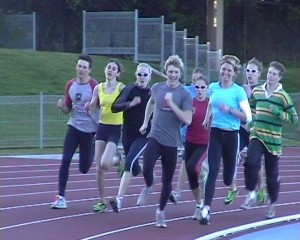For many years now debate has raged between advocates of the two extremes of training for middle distances. We have had athletes who have been on well over 160km a week running great times in 1500m and also some running very fast off a much smaller volume of in some cases less than 100km a week.
Both extremes of training can work for an athlete. What the high volume athlete lacks in intensity can be ‘made up’ from the benefits of the slow stimulus of volumes of aerobic running. What the lower volume athlete lacks in volume can be ‘made up’ for with extra intensity. There are trade-offs and risks of both extremes however and this is essential when working out what is best for a given athlete.
The high volume athlete runs the risk of overuse injuries and this is especially so if the training includes a high percentage on the roads. They also run the risk of lowering running efficiency at race pace if good form work is not done to compensate for the potentially damaging effects of running slower most of the time. The athlete can lose speed & ease of speed. Some would argue though that increased mitochondrial density and capillarization brought about in a more extreme fashion by high volume training will in fact improve efficiency – as will the extra muscular conditioning of the lower legs from running slowly with a minimal knee lift.
The low volume athlete because of the higher intensity will face a much higher risk of overtraining & burnout both mentally and physically. I know of athletes whose immune system has let them down and they became repeatedly sick because of the steady regime of highly anaerobic work they were doing for most of each year. I believe athletes don’t last long like this, they have short careers. This may be especially true for female athletes.
Many of the best athletes in the World that lasted for the longest were in fact higher volume athletes like John Walker.
I believe the answer to the debate is to do both, periodize (plan) the year smartly, build to high volumes in the offseason on softer varied surfaces, be cautious with highly lactic speedwork save it for the pre-comp period. Let athletes aim for goals that are within the next 3 months XC races etc. But in base building periods train at intensities that are certainly well within the coping capacities of the athlete. Do good running form – “ease of speed” development sessions most of the year but keep the volumes and intensities at a level that fits with the volume the athletes are doing. By intensity I mean lactic intensity eg 4 x 150m at high speed is not near as intense as 4 x 200m at the same speed. The extra 50m puts the athlete into the lactic zone much more just like 4 x 300m at same speed would be much more intense again. Speed can be developed and maintained safely in terms of musculoskeletal injuries from sessions of faster shorter reps with a total session volume of reps of less than 1000m eg 4-6 x 150m at a good speed with plenty of rest (2min+)and 8min between sets if needed. This is a very effective ease of speed development and form workout that is not that intense (especially if rests are longer like in excess of 5min).
There is a common tendency for endurance squads to focus almost exclusively on interval training with short rests between reps. The forgotten diamond is when building toward peak season to do interval sessions with much longer rests at very high intensity. Examples are:
3 x 400m rest 8min at faster then 1st lap of an 800m race pace.
5 x 300m rest 5min at faster than 1st lap 800m race pace.
800-600-400 with 12min active rest at 1500m race pace and better.
4 x 200m rest 5min at 400m race pace
The above sessions are the missing ingredients in many programs.
The only way they could be anywhere near replaced is with racing itself.
I once saw a 1:47 800m athlete do 3 x flying start 400m runs in mid47s with only 8min rest in between. This was a much tougher ordeal physiologically than an 800m race.
With sessions like 4 x 2000m rest 3min there are many ways to run it.
They can be run at 5000m pace or faster i.e as hard as the athlete possibly can.
They could also be done at 10000m race pace which is a bit above the Anaerobic threshold pace. The 10km pace version is much more sustainable over many months of base training and can easily be preceded by a long warmup and a long warm-down. The faster “eyeballs out” approach to the session is certainly not something that an athlete can sustain for many months even though gains in Vo2max may be high. Training is all about having optimal adaptation, not just quick adaptation. Sometimes slow adaptations from many areas can add up to elite performances because the athlete can be sitting at a level where just 2 months of comp prep intense training combined with racing can lift them to a super high level FROM what was a pretty low-intensity regime of significant volume. BUT they need those ease of speed sessions to be comfortable running fast again.
I believe now that especially with female athletes transitioning from juniors to seniors we need to increase the volume & be cautious with the intensity but continue the speed development. Most will last better as long as their bodies suit it on 80-100km a week of steady running than 40-60km of hard fast running.
It is essential that athletes all do both a volume that their biomechanical structures can handle and the intensity that their physiology can cope with. Eventually, their ability to maximally adapt to both at the right time is the key to optimal performances in MD events.
Loving their training & variety of stimulus is the key. Putting enough solid work in that the effects over a longer period of terms unveil unexpected improvements in performance when the time is right.
Having a large group of training pals and doing sessions they can do together without racing all the time is key to long term longevity for senior athletes and also those transitioning from late school years to jobs/uni etc.

